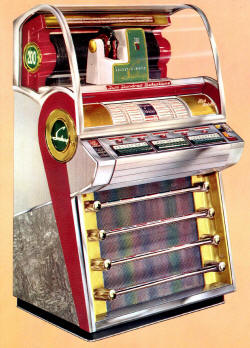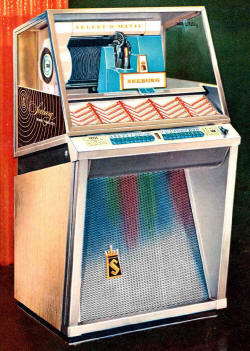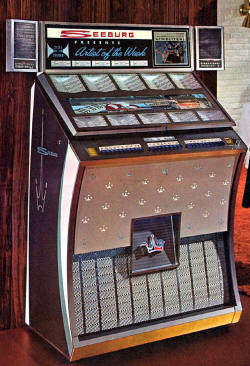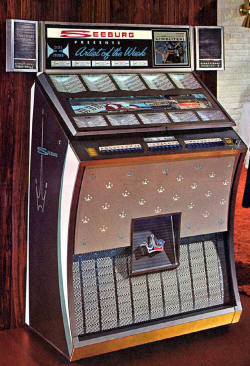 | |
 | M100B 100 Selections, 45 RPM. Introduced October, 1950. Price: $975. �. 2 plays, 10�. 6 plays, 25�. Fast-forward to 1950. Seeburg worked with RCA to introduce the 45 RPM record to the public, while claiming that they would only go to 45 RPM when the public demanded it. Styling-wise, this is a warmover of the M100A design. This and all later machines until 1986 used the same basic mechanism. Later machines would introduce 200 and then 160 selections (using a wider base plate and magazine) and newer pickups (including stereo), but the basic design remained the same for 36 years! Talk about a well-designed and bullet-proof machine. Also, the selection system would be updated as technology permitted. The original selection system used 100 magnet-operated levers to indicate that a selection had been made. In 1955, this was replaced with the famous Tormat (having no moving parts). Finally, a semiconductor memory replaced the Tormat in 1978. There was also a model M100BL, identical except that the cabinet wood is lighter in color (blonde), and the mechanism is green and its cover is silver. The front mirrors have a bluish tint. Thanks for Pat Miller (no relation) for passing this information on. It was introduced in October, 1951, and cost $1050. A hideaway version (HM100B) was introduced in July, 1951, and cost $862. |
 | M100C 100 Selections, 45 RPM. Introduced May, 1952. Price $1050. �. 2 plays, 10�. 6 plays, 25�. A brand-new cabinet design featuring rotating color cylinders in the translucent pilasters to attract customer attention. A hideaway version of this machine (HM100C) was introduced in May, 1952, and cost $862. |
 | 100W 100 Selections, 45 RPM. Introduced September, 1953. Price $1050. �. 2 plays, 10�. 6 plays, 25�. Yet another warmover of the M100C cabinet, this time with bright graphics on the pilasters. A hideaway version of this machine (H100W) was introduced in September, 1953, and cost $862. |
 | HF100G 100 Selections, 45 RPM. Introduced September, 1953. Price $1095. �. 2 plays, 10�. 6 plays, 25�. This is a warmover of the M100C cabinet, with the translucent pilasters replaced with stainless steel. Probably, many operators complained of customers breaking the pilasters with their barstools or feet. With this model, Seeburg introduced the first coin-op 'high-fidelity' system, with an improved amplifier and multiple speakers. A 15-inch woofer and a 5-inch tweeter were u sed, with the low-frequency sounds directed to the woofer, and high frequency sounds went to the tweeter. A hideaway version of this machine (HHF100G) was introduced in January, 1954, and cost $895. |
 | HF100R 100 Selections, 45 RPM. Introduced August, 1954. Price $1095. �. 2 plays, 10�. 6 plays, 25�. A hideaway version of this machine (HHF100R) was introduced in August, 1954, and cost $895. Brand-new cabinet design, featuring maximum visibility of the mechanism
|
 | 100J 100 Selections, 45 RPM. Introduced August, 1955. Price $1095. �. 2 plays, 10�. 6 plays, 25�. The 100JL was introduced in October, 1956 and is similar, using a different mechanism, selector, and color scheme. Its price was $1145.
|
 | V200N 200 Selections, 45 RPM. Singles cost 5�, Extended Play (EP) records cost 10�. V200D 200 Selections, 45 RPM. Singles cost 10�, EP records cost 15�. Introduced August, 1955. Price $1195. Dual pricing. Here, Seeburg introduced three major innovations: 200 selections, dual pricing, and the solid-state Tormat memory. Just when the competition had caught up with 100 selections (some had temporarily eclipsed Seeburg with 120), Seeburg turned around and offered 200 selections. For Seeburg, this was a simple change, just revise the base casting and put more separators in the record magazine, especially as compared to everyone else, who would have to redesign their entire carousel systems to keep up. But to keep cabinet width reasonable, the spacing between records was decreased, making the entire mechanism a bit narrower. This also helped to cut down on the 'dead time' between records. Dual pricing offered the possibility of charging more for playing an EP record, having two selections per side. The Tormat used computer memory cores to remember which selections had been made but not yet played, replacing the magnet-operated levers used in the previous machines. Another innovation is the motor-operated selection drum. With 200 selections, a significant amount of cabinet would be taken up by the title strips. Instead, 40 selections are displayed at a time, with five push-button switches used to move between selection groups. The groups included: Hit Tunes, Rhythm & Blues, Folk & Western, All-time Favorites, and Classics & Varieties. The motor-operated drum sometimes gave problems, so aftermarket suppliers such as Wico, Inc., offered a 'flat-top' kit to replace the upper portion of the cabinet with a title board displaying all 200 titles. Unfortunately, this detracts from the value of the machine. The horizontal grille bars of this machine, shows the Detroit styling influence, similar to the automobiles of the time. There was also a hideaway version of this machine (HV200) introduced in August, 1955. It cost $975. The VL200 was introduced in October, 1956, and is similar, with different cabinet and mechanism colors. This machine featured an improved version of the Tormat selection system, which was simplified, and made more reliable. Its price was $1295. As in the V200, there were two versions: VL200N with nickel play singles, dime play EPs, and VL200D with dime play singles and 15� EPs. There was also a hideaway version of this machine (HVL200) introduced in October, 1956. It cost $990. There was also a kit to replace the TSR1 (Tormat Selection Receiver) of the V200 with the improved TSR3 used in the VL200. Machines so converted were called V200X.
|
 | KS200 200 Selections, 45 RPM. Single Pricing KS200H 200 Selections, 45 RPM, Single Pricing. Accepts half dollars. KD200 200 Selections, 45 RPM. Dual Pricing. KD200H 200 Selections, 45 RPM, Dual Pricing. Accepts half dollars. Introduced March, 1957. Price: $1325. New cabinet design that still used the rotary drum title strip setup of the V. Unfortunately, a printed circuit board system was introduced for this model and the L100 (see below) which proved to be unreliable. The combination of the early printed circuit board (PCB) material, eyelets to make connection between the top and bottom sides of the PCB, solder flux, and the high temperatures from the tubes caused many intermittent problems with the electronics in this machine. Many of these problems were caused by service personnel flexing the PCB when installing new tubes, which led to broken PC traces. Once repaired and with caution observed when servicing, these machines continue to entertain their owners. The Detroit-inspired styling is readily apparent with the three tailfins below the selector. There was also a hideaway version of this machine (HK200). |
 | L100 100 Selections, 45 RPM. L100H 100 Selections, 45 RPM. Accepts half dollars. Introduced March, 1957. Price: $1095. With this model, Seeburg introduced the two model concept: 200 selections for the top-of-the-line locations, 100 selections for smaller locations and export. This machine also featured the electronics on PCB, and shares the reliability problems of the KS/KD200. Both machines, if properly repaired with special attention paid to insuring solid connections between the components and PCB, will give years of solid listening pleasure. |
 | 101 100 Selections, 45 RPM. Single pricing only. Introduced January, 1958. Price: $1095. Note this picture is the same as the previous one. The difference between machines is that the 101 did away with the printed circuit board amplifier and selection receiver, reverting to the tried-and-true directly wired chassis. Seeburg would not return to using printed circuit boards until 1968, with the introduction of the LS2, even though all machines built after the 1964 LPC480 were all solid-state, removing the heat source (the tubes) which was so problematic with the KS/KD200 and L100. |
 | 161S 160 Selections, 45 RPM. Single Pricing. 161SH 160 Selections, 45 RPM. Single Pricing. Accepts half dollars. 161D 160 Selections, 45 RPM. Dual Pricing. 161DH 160 Selections, 45 RPM. Dual Pricing. Accepts half dollars. Introduced January, 1958. Price: $1275. Seeburg introduced what was to become its and industry's standard number of selections, 160. EP (Extended Play) record play was featured, using a dual pricing unit to permit those EPs to be charged at a higher rate. EPs had two songs per record side. |
 | 201S 200 Selections, 45 RPM. Single Pricing. 201SH 200 Selections, 45 RPM. Single Pricing. Accepts half dollars 201D 200 Selections, 45 RPM. Dual Pricing. 201DH 200 Selections, 45 RPM. Dual Pricing. Accepts half dollars Introduced January, 1958. Price: $1350. Note the styling similarity between this machine and the 161 preceding. While the cabinet is wider to accommodate the 200 selection mechanism, the most notable difference is the number of 'tail lights': the 201 has three, while the 161 has only two. The taillights are identical to those used in the KS200 and KD200. The cabinet is also similar, but the selection drum has been eliminated. These two machines are the high point of Seeburg's Detroit styling influence. This will be the last 200-selection machine built by Seeburg for several years. Only in 1982 did Seeburg offer another 200-selection machine, the low-production VMC. There was also a hideaway version of this machine (H201). |
 | 220S 100 Selections, 45 RPM. Single Pricing. 220SH 100 Selections, 45 RPM. Single Pricing. Accepts half dollars. 220D 100 Selections, 45 RPM. Dual Pricing. 220DH 100 Selections, 45 RPM. Dual Pricing. Accepts half dollars. Introduced October, 1958. Price: $1420 This machine and the 222 (following) were the first jukeboxes to offer stereophonic sound, which Seeburg made a big deal of with the 'Channel 1', 'Channel 2' prominent styling cues. Otherwise, the cabinets are very similar to the preceding 161 and 201. |
 | 222S 160 Selections, 45 RPM. Single Pricing. 222SH 160 Selections, 45 RPM. Single Pricing. Accepts half dollars. 222D 160 Selections, 45 RPM. Dual Pricing. 222DH 160 Selections, 45 RPM. Dual Pricing. Accepts half dollars. Introduced October, 1958. Price: $1575. See comments above regarding the introduction of stereo sound. Actually, the stereo effect was minimal given the separation between channels (on the order of about two feet). This would finally be addressed with the DS100 and DS160 of 1961 (see below), the last of the 'Silver Age' machines. Note the virtually identical appearance between this and the 220. The main difference is the additional panel of title strips above the mechanism. There was also a hideaway version of this machine (H222). |
 | Q100 100 Selections, 45 RPM native, 33⅓ RPM with optional Auto-Speed engaged. Machines equipped with the Auto-Speed from the factory were AQ100. Single Pricing. Q100H 100 Selections, 45 RPM native, 33⅓ RPM with optional Auto-Speed engaged. Single Pricing. Accepts half dollars. Q100A 100 Selections, 45 RPM native, 33⅓ RPM with optional Auto-Speed engaged. Accumulative Pricing, which means that several coins could be inserted before selections were made. Q100AH 100 Selections, 45 RPM native, 33⅓ RPM with optional Auto-Speed engaged. Accumulative Pricing. Accepts half dollars Introduced November, 1959. Price: $1325. This and the Q160 (below) introduced the 'Little LP' concept, replacing the EP 45 RPM records having two selections per side with a 33 1/3 7-inch record with three selections per side. In order to play these records, an optional Auto-Speed electronic power oscillator was required, to change the frequency of the AC power to the mechanism motor from the nominal 60 Hz (U.S.) to about 44 Hz. For Europe and Japan, the motor Mains supply was changed from 50 to about 36 Hz. When so equipped, the model number became AQ100 ('A' signifying Album play). The albums were the standard 7-inch diameter, but had a smaller center hole (5/16 inch) versus the nominal 1 1/4 inch center hole of the 45 RPM record. The smaller hole prevented the mechanism clamp arm from inserting completely into the record, closing a switch to activate the Auto-Speed. Many 45 RPM singles in Europe also use the smaller center hole, requiring the use of a 'dinker' to permit them to be played machines equipped with the Auto-Speed. This model introduced a new cabinet design. Mechanism visibility is starting to be restricted, with more space taken up by the title strips and graphics. There was also a hideaway version of this machine (HQ100SR). |
 | Q160 160 Selections, 45 RPM native, 33⅓ RPM with optional Auto-Speed engaged. Machines equipped with the Auto-Speed from the factory were AQ160. Single Pricing. Q160H 160 Selections, 45 RPM native, 33⅓ RPM with optional Auto-Speed engaged. Single Pricing. Accepts half dollars. Q160A 160 Selections, 45 RPM native, 33⅓ RPM with optional Auto-Speed engaged. Accumulative Pricing. Q160AH 160 Selections, 45 RPM native, 33⅓ RPM with optional Auto-Speed engaged. Accumulative Pricing. Accepts half dollars. Introduced November, 1959. Price: $1490. When equipped to play albums, the model number becomes AQ160. Note the extended top panel to mount the additional title strips. Other than that, the cabinets are identical. |
 | AY100 100 Selections, 45 RPM native, 33⅓ RPM with Auto-Speed engaged. Single Pricing. AY100H 100 Selections, 45 RPM native, 33⅓ RPM with Auto-Speed engaged. Single Pricing. Accepts half dollars. AY100A 100 Selections, 45 RPM native, 33⅓ RPM with Auto-Speed engaged. Accumulative Pricing. AY100AH 100 Selections, 45 RPM native, 33⅓ RPM with Auto-Speed engaged. Accumulative Pricing. Accepts half dollars. AY100U 100 Selections, 45 RPM native, 33⅓ RPM with Auto-Speed engaged. Universal Pricing. A new Pricing Unit was introduced, which gave much more flexibility in determining cost per play. Introduced October, 1960. Price: $1490. With no Auto-Speed, this machine becomes the Y100. The Universal Pricing version of this machine (AY100U) was introduced in April, 1961. A hideaway version of this machine (HY100UR) was also available. Same basic cabinet as the Q100, Q160. |
 | AY160 160 Selections, 45 RPM native, 33⅓ RPM with Auto-Speed engaged. Single Pricing. AY160H 160 Selections, 45 RPM native, 33⅓ RPM with Auto-Speed engaged. Single Pricing. Accepts half dollars. AY160A 160 Selections, 45 RPM native, 33⅓ RPM with Auto-Speed engaged. Accumulative Pricing. AY160AH 160 Selections, 45 RPM native, 33⅓ RPM with Auto-Speed engaged. Accumulative Pricing. Accepts half dollars. AY160U 160 Selections, 45 RPM native, 33⅓ RPM with Auto-Speed engaged. Universal Pricing. Introduced October, 1960. Price: $1512. With no Auto-Speed, this machine becomes the Y160. This machine introduced the 'Artist of the Week' program, in which every week a different artist was featured, along with a small album cover at the right of the vertical panel. Here, the additional title strips are positioned below the vanishing mechanism viewing glass. This is the first Seeburg machine to be named by the marketing department. Its name is 'Artist of the Week'. The Universal Pricing version of this machine (AY160U) was introduced in April, 1961. A hideaway version of this machine (HY160UR) was also available. Same basic cabinet as the Q100, Q160. |
| DS100U 100 Selections, 45 RPM native, 33⅓ RPM with Auto-Speed engaged. Universal Pricing. Introduced December, 1961. Price: $1530. Very similar to the DS160 below. Photo provided by Patrick Jordan. Thanks, Patrick! The only exterior difference between this machine and the DS160 is that the title strips below the small mechanism viewing window have been deleted, and replaced with graphics showing un-attached hands playing instruments. The instruments are (left to right) trombone (my oldest son plays a mean trombone!), clarinet, trumpet, and guitar. These graphics are identical to those on the AY100, above. 'DS' stands for Directional Stereo. Same basic cabinet as the Q100, Q160. | |
 | DS160U 160 Selections, 45 RPM native, 33⅓ RPM with Auto-Speed engaged. Universal Pricing. Introduced December, 1961. Price: $1572. Artist of the Week is again a big deal. Note the 'ear' speakers, to the left and right of the top panel. Each speaker could be positioned so as to direct the sound away from the machine, giving a better sense of stereo separation. The ear speakers give this machine its name: 'Directional Stereo'. Same basic cabinet as the Q100, Q160. This is the last machine of the 'Silver Age'. The next year Seeburg introduced the LPC1 'LP Console'. Click here to see it. |
class="F4 Bold FontArial Black"
